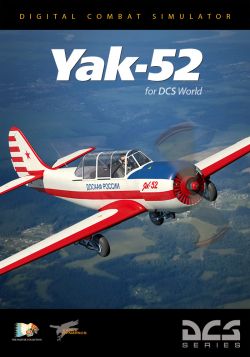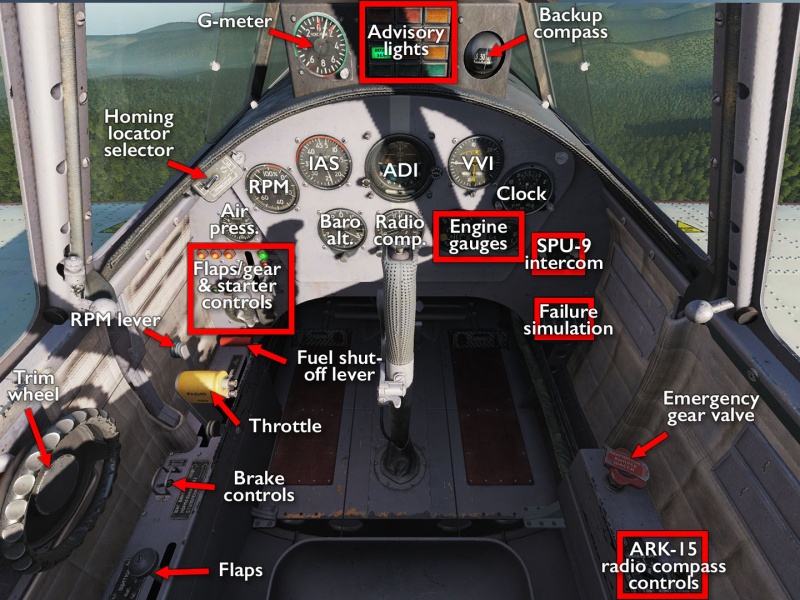Yak-52
| This is an alpha module.
This module is still being developed and is missing central features and equipment options. While it is playable, it may have major bugs, and procedures may have inconsistent or unexpected results. The intrepid and very interested may want to buy it; others should probably wait for a more stable or complete release. |
The Як-52 is a 1970:s Soviet trainer aircraft for volunteer “sport pilots” that could serve as a reserve for civilian and military air services. It also took on, and remains in, the role of an easy-to-fly agile aerobatics aircraft. In the context of DCS World, it serves almost as an even earlier step than the L-39 in the progression of learning how to fly, and shares many of the Albatros' features.
From a more technical standpoint, the Yak-52 is Eagle Dynamics' testbed for simulating radial-engine prop planes, which would provide them with a broader foundation to build future aircraft. Since they do a fair amount of commission work, this would allow them to attract new clients, and getting a DCS module out of it is just a bonus.
Features
Even more so than the L-39C, the Yak-52 is a trainer aircraft, and this is readily apparent in the feature list. At the same time, aside from that small detail, the overlapping relationship and role progression between the two aircraft is also readily apparent:
- No weapons of any kind — this is all about the flying.
- A simple VHF radio and NDB-based radio navigation.
- A proper tricycle landing gear (this is a big deal compared to earlier DCS prop planes)
- Differential braking rather than nose-wheel steering.
- Multicrew — act as a proper
back-seat driverinstructor to your poor trainee friend in the front seat. - A manual that features more chapters on proper flying technique and common pilot errors than any other topic.
Missing features
The Yak-52 is still early in its development cycle and is marked early access in the DCS store for good reason. Nothing is likely to break or explode unexpectedly, and with few on-board systems, there is little that even can be considered missing as long as the thing flies. Nevertheless, there are some obvious gaps in the simulation at this point:
- Flight dynamics and mechanical performance still need a lot of tweaking.
- There are numerous missing or non-functional keybinds.
- The manual is lacking in describing what few systems and instruments are actually available.
- Basic functions like radio, and navigation instruments are still work in progress, and the published procedures include steps that involve these non-functional systems.
The latter two in particular means that a literal reading of the manual can sometimes lead to situations where “proper procedures” will outright destroy the aircraft. A bit of common sense will work around that, but until the module is complete, some flexibility on the pilot's part is a definite requirement
Flying the Yak-52
While it is a propeller aircraft, the Yak-52 should not be confused with the WWII prop planes previously featured in DCS. This is an aircraft built almost half a century later, meant to teach flying rather than to be a temperamental high-performance combat airplane. You still have to manage cooling valves, RPM, throttle settings, and keep an eye on manifold pressures like in the olden days, but it is all much more “set it and forget it” than in the fighter planes.
In short, the Yak-52 is very easy and forgiving to fly. It only has elevator trim, but does not need much more, and it will happily and snappily respond to the pilot's inputs. While it will stall if you get down to double-digit speeds, it is actually somewhat difficult to make it depart from controlled flight. It will happily do anything between -5(!) – +7 G without inducing an undesired slips, rolls or spins , and the pilot is more likely to come apart before the airframe does during any more extreme manoeuvres.
Cockpit overview
Getting into the air
By virtue of its nature as a training aircraft and its only have a handful of simple systems, the Yak-52 is fairly easy to get off the ground. Anyone who has spent any time in the other DCS propeller aircraft will feel right at home, yet be relieved of how much less temperamental the Yak is. The major snag to look out for is the interaction between the front and rear cabins, where the wrong settings in the rear can cause unpleasant things to happen in the front (such as the engine starting prematurely or not at all, or the landing gear folding up underneath you).
For the full procedure, refer to the manual (keeping in mind that some things are not implemented yet) or the checklist linked below, but the short version is:
- Make sure the flaps and gear levers in the rear cabin are set to the neutral positions.
- Ensure that the front cabin flaps lever is up and gear lever is down.
- Turn on the air pressure.
- Turn on battery and other electrics, the stall warning systems just below that, and all the system circuit breakers on the left.
- Push prop pitch and fuel cutoff levers fully forward; push throttle ⅓ forward.
- Request wheel chocks, or you will probably leap into the nearest tree when the engine starts.
- Turn the fuel pump handle to the right and give it 5–6 pulls (in the summer; 8–12 in the winter) to prime the engine.
- Turn the fuel pump handle to the left and check a couple of pumps to pressurise the fuel pipes.
- Turn the magneto switch to 1+2 and press the start button (technically it is the other way around, but you will need to use two hands and keybinds for that — in practice this way works just fine if you only use the mouse).
- Adjust the throttle to set RPM at ~40% (leaving the prop lever fully forward) to warm up the engine.
- Adjust the coolant levers to depending on the outside conditions so you do not overheat.
- Use differential braking (left/right rudder + the brake handle) to make your way to the runway, and take off in the normal fashion.
The Yak-52 does not have pilot-controlled rudder and aileron trim so you may have to apply some stick and pedal input just to move in a straight line down the runway. Note, however, that the real aircraft does have fixed trim tab settings that can dialled in for level flight at cruising speed. In DCS, these trim tabs are set using the Special options tab, and will require some trial-and-error (or just an updated manual) to set right… once they are implemented, which has yet to happen.
Links and files
- Tippis' Checklist (see also kneeboard mods).
- Chuck's Yak-52 guide at Mudspike.
- DCS: Yak-52 in the DCS shop.
More information
- Yakovlev Yak-52 on wikpedia.
- Yak-52 on globalsecurity.org






